Sealant Joint Solutions
by Samantha Ashenhurst | June 14, 2018 9:11 am
 [1]
[1]by Arthur L. Sanders, AIA, and Lawrence E. Keenan, AIA, PE
In both new construction and rehabilitation projects, sealant joints are often given short shrift when it comes to time and attention, as well as budget. Sealants often comprise the lowest percentage of a project’s overall cost—this is surprising considering all these products are asked to do.
As modern buildings have moved away from mass walls toward lighter, more pliant construction, designers rely on sealants to buffer those moving parts. With their multiple wythes and drainage channels, mass walls were designed to absorb and shed water before it reached the inner surface of the wall. Curtain walls and lightweight cavity walls depend on sealant joints to not only accommodate movement, but also to help keep the building interior dry. This is a lot to ask of a building element, especially one usually afforded only passing consideration.
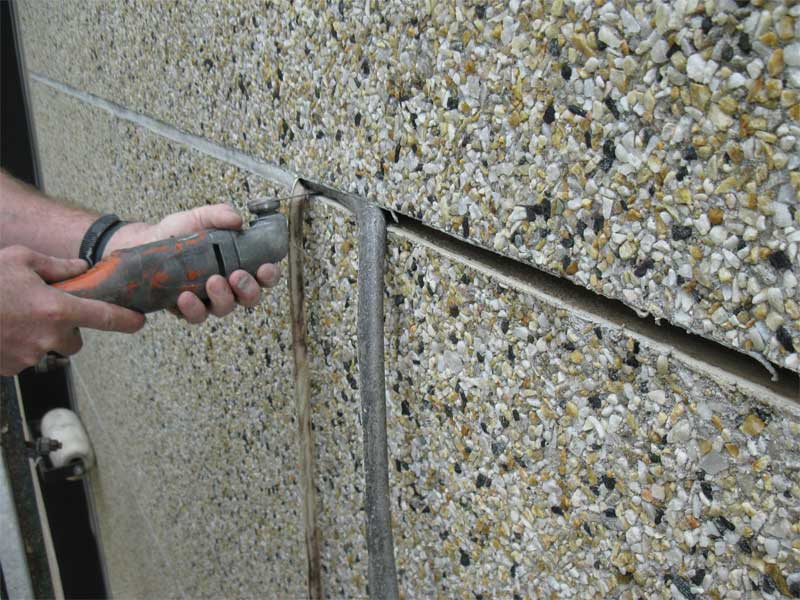 [2]
[2]Precast concrete construction relies on sealant more than any other building type. Parking structures, in particular, have miles of sealant joints that must be maintained and periodically replaced. These joints frequently suffer from poor design and/or installation, as well as damage from high-heeled shoes and snowplow blades.
When sealant joint failure occurs, it can wreak havoc on the building envelope. Many joints are difficult to repair, and some concealed joints may be impossible to fix without demolition and reconstruction. Therefore, it is critical to design joints correctly, and to specify and properly apply an appropriate sealant. Before having a handyman attack cracked or missing sealant with a caulk gun, one must consider the substantial costs of rehabilitating water damage should the caulk fail. In the bigger picture, it is worth spending the time and energy on well-designed sealant joints to prevent premature degradation of building materials.
An age-old problem
Although naturally occurring bitumen- and asphalt-based materials have been used as building sealers for centuries, modern polymeric sealants were developed relatively recently. Acrylics and polyurethanes emerged in the 1930s, while water-based epoxies and silyl-terminated polyethers were not developed until the 1980s and 1990s, respectively. New sealant types, including proprietary mixtures, regularly appear on the market, each claiming to surpass the performance of previous generations of sealant products.
Modern sealants are composed of two basic elements: an elastomeric compound for flexibility, and some type of filler. During the mid-20th century, asbestos was a common sealant component, and poly-chlorinated biphenyl (PCB) was often added to impart desirable properties to the sealant. Unfortunately, subsequent research has linked both compounds with cancer, and the resultant cleanup process has led to no end of trouble for building owners and rehabilitation teams alike. (See “PCBs in Sealants.”)
Elastomers do just what their name says: they stretch. Sealants are usually polymers, composed of more than one type of elastic material. These pliable compounds bridge gaps at moving joints, where two building elements that move differentially intersect, as well as at static joints, which are relatively stable. Today’s sealants vary in composition to accommodate different applications, whether a high-movement expansion joint, a structural glazing seal, or a concrete control joint.
 [3]
[3]Sealant types and properties
For residential and commercial applications, the six most common types of sealants are:
- water-based latex;
- solvent-based acrylic latex (acrylics);
- butyl;
- polysulfide;
- silicone; and
- polyurethane.
No one sealant type is universally better or worse than another; some are better-suited to a given application than others due to their physical and chemical properties.
Latex sealants
These sealants are popular for residential use because they are easy to apply, adhere well to most substrates, and are generally paintable. For low-movement applications, they are an economical option that gets the job done. Where they fall short is in situations where a high movement capability is necessary, such as for high-rise buildings and moving joints. Latex is also prone to shrink, pulling away from the substrate and leaving open gaps where water can penetrate.
Acrylics
Acrylics are mainly used in exterior applications, where their ultraviolet (UV) stability puts them at an advantage over water-based latex. They are also less likely to shrink over time. On the downside, acrylics can be difficult to tool, and they do not perform well in high-movement areas.
Butyls
Adhering well to a wide variety of substrates, butyls can be difficult to apply due to their stringy consistency. These sealants also have poor resistance to abrasion and shear forces, which limits their performance in demanding building applications.
Polysulfides
Polysulfides can accommodate submerged applications, such as in a fountain or pool. They have excellent flexibility, even at low temperatures, and they exhibit little shrinkage or UV degradation. However, they are expensive, and tend to have high levels of volatile organic compounds (VOCs). At 10 to 20 years, the long life expectancy for polysulfides may help compensate for the upfront costs, particularly considering the difficulty of re-sealing an underwater surface.
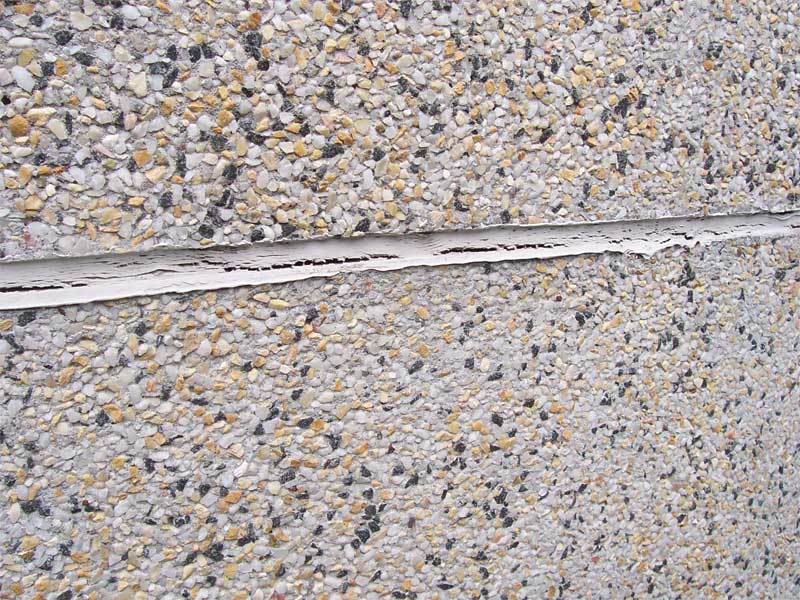 [4]
[4]Polyisobutylenes
With similar properties to natural rubber yet significantly better aging characteristics, polyisobutylene resins are used in sealant formulations because they resist degradation due to aging and chemical attack, and they have low permeability. Often the primary seal in insulating glazing unit (IGU) window applications, they resist vapor transmission and prevent the inert gas between glass panes from leaking. Typically, a silicone secondary seal is employed in conjunction with the polyisobutylene for durability and long-term adhesion. Usually formulated as hot-melt sealants, polyisobutylenes melt mix with ease.
Silicones
Silicones have excellent thermal resistance, dynamic movement capability, and good adhesion, but silicones are easily vandalized and tend to collect dirt. For some substrates, staining may be an issue. In addition to general sealant applications, silicones are also commonly used as structural glazing sealants, securing sheets of glass to framing elements. Of all the common sealant types, silicones tend to be the most expensive—however, they also have the longest service life.
Polyurethanes
These sealants adhere well to most surfaces with little substrate preparation, making them the go-to sealant of many contractors. Their excellent resistance to abrasion and shear forces, along with strong adhesion and movement capability, make them a good choice for applications such as plazas, which demand durability and resilience.
| PCBs IN SEALANTS |
| Polychlorinated biphenyls (PCBs) were a common additive to sealants from the 1950s until they were banned in the United States in 1979. Thanks to their elasticity and chemical stability, they were added as plasticizers to building sealant used for windows and masonry. Exposure to PCBs can cause cancer, as well as endocrine disruption, immune suppression, liver damage, reproductive system failure, and neurotoxicity.
PCBs are regulated under the Toxic Substances Control Act, but state and regional regulations vary as to their safe disposal. Since PCBs can leach into the surrounding substrate or soil, abatement may involve demolition and/or excavation, adding substantial time and expense to a sealant replacement project. At a minimum, containment measures must be put in place during rehabilitation to prevent PCB-containing dust from becoming airborne. Site access should be limited, and workers must wear appropriate protective clothing and respiratory equipment. Removal methods should minimize heat generation, as PCB gases may be released into the air in response to high temperature. Also avoid grinding, which produces dust and may lead to aspiration of PCBs. PCBs can be a formidable obstacle to sealant joint rehabilitation. However, the potential health consequences of negligence outweigh the inconvenience and expense of proper abatement. |
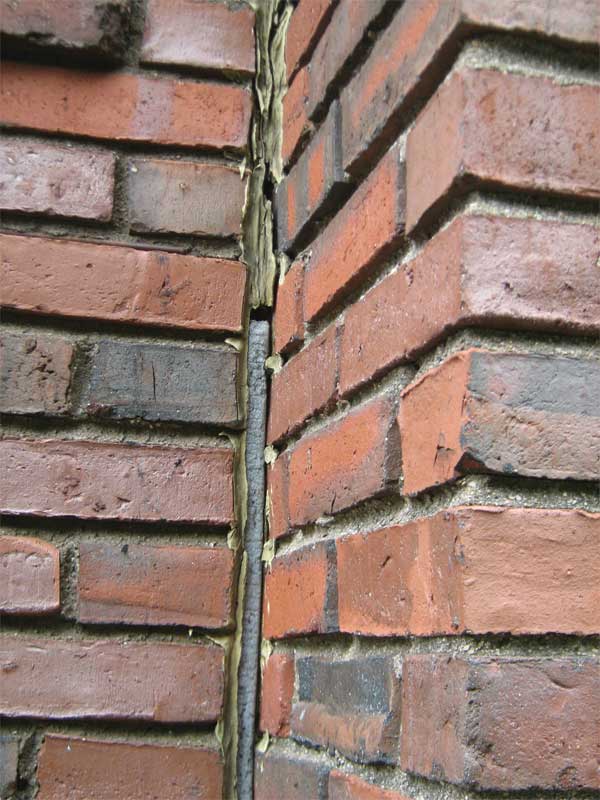 [5]
[5]Properties of sealants
When selecting a sealant, one must consider the properties most impacting the specific application at hand. Here are the key sealant properties building professionals must evaluate.
Consistency
Sealants are available in pourable or non-sag formulations. Pourable sealants have a fluid consistency for use in horizontal joints, where they are self-leveling. Non-sag sealants are thicker and will not run down sloped or vertical joints.
Durability
The expected service life of a sealant under ideal conditions may not be the same as the actual field lifespan, especially if the sealant was misapplied or incompatible with the substrate. Generally speaking, silicones have the longest service life, estimated at 20 years or more, while some acrylics and butyls last little more than five.
Hardness
The harder a sealant, the greater its resistance to traffic and vandalism. However, as hardness increases, flexibility decreases, so the trick is to find the right balance of damage resistance and movement capability for a given situation.
Exposure resistance
The best exterior-grade sealants perform well in response to sun, temperature extremes, and moisture. Measures of exposure resistance include flexibility at low temperatures, freeze-thaw resistance, UV stability, and susceptibility to heat aging.
Movement capability
The higher a sealant’s movement capability, the more elongation or compression it can withstand without failure. Movement capability is expressed as a percentage of the joint width. For example, a sealant with ±10 percent movement capability in a 25-mm (1-in.) joint can stretch to 28 mm (1.10 in.) or contract to 23 mm (0.90 in.), and recover.
Modulus
Short for “modulus of elasticity,” modulus refers to sealant stress at a given elongation. Low-modulus sealants usually have high movement capability, and vice versa, although this is not always the case. Low-modulus sealants are generally employed for delicate substrates, for which it is desirable to have low stress at the joint edge. High-modulus sealants are best used for static, non-moving joints, because they exert a very high force on the substrate when stretched. Medium-modulus sealants are general-purpose products balancing stress at the adhesion surface with stiffness of the sealant.
Adhesion
The ability of a sealant to adhere to construction materials is an essential property to consider. Test methods such as ASTM C794, Standard Test Method for Adhesion-in-Peel of Elastomeric Joint Sealants, can evaluate the adhesion of elastomeric sealants. Manufacturers also provide data on sealant adhesion for various substrates.
Staining
The components of some sealants may leach into porous substrates, particularly natural stone, leaving a visible stain. To evaluate compatibility with the substrate, even sealants rated as non-staining should be tested in an unobtrusive area before use.
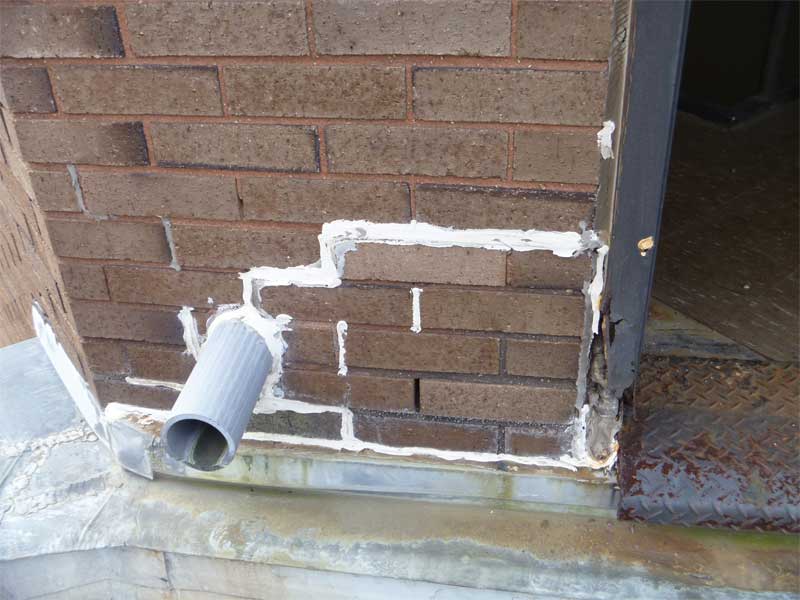 [6]
[6]VOC content
Emission of volatile organic compounds from building products is regulated at the state and regional level. For occupied buildings, VOCs are a particularly important consideration. While most manufacturers have developed low-VOC sealants, some types have lower levels than others. Solvent-based sealants tend to have higher levels of respiratory irritants and environmental toxins, but VOC content varies widely by product.
Ease of application
Curing characteristics and toolability are the two major factors affecting a sealant’s ease of application. Toolability refers to the ease of achieving a smooth surface of correct geometry. Curing properties vary widely, from fast-curing sealants to those, such as polyisobutylene, that are designed to remain uncured.
Cost
As is the case with most building products, cheapest is not usually the best. In general, higher cost means higher performance. However, opting for a high-performance sealant when a less expensive alternative would do the job may mean one is overspending. Scrimping on sealants is not likely to do the prudent building owner any favors, though, as replacing failed sealants is nearly always more expensive than selecting the right sealant in the first place.
Causes of sealant failure
One of the most common causes of sealant failure stems not from the sealant itself, but from the size and spacing of the joints, which must be sufficient in number and in spacing to allow for seismic forces, thermal cycling, and differential movement of substrate materials. Different sealants have differing abilities to accommodate shear stress, caused by the faces of the joint sliding past one another, along with expansion and contraction as fluctuating temperatures cause the joint to widen or narrow.
Joints spaced too narrow or widely may force sealant to stretch beyond its capacity, which can cause the sealant to pull away from the substrate (adhesive failure) or to tear within itself (cohesive failure). Expansion of the substrate may compress the sealant beyond its tolerance, causing it to extrude out of the joint. An excessively wide joint may not be able to accept sealant at all, as it is likely to slough out of the large gap.
Properly designed sealant joints generally have a 2:1 width-to-depth ratio, a configuration allowing the joint to accommodate movement most effectively. Additionally, many manufacturers stipulate maximum and minimum dimensions in order for the sealant bead to perform within its movement capability.
 [7]
[7]Inappropriate selection
In addition to correct joint design, selection of a sealant product with the ability to withstand anticipated building movement is critical to avoid premature failure. Inadequate provision for movement, either by underestimating the amount of movement or by using a sealant with insufficient movement capability, can cause even correctly proportioned joints to fail.
Fountains, parking garages, plazas, schools, and other sites subject to vandalism, water, and weather conditions demand sealant with superior abrasion resistance. High-heeled shoes—the bane of the precast concrete parking garage owner—are notorious for puncturing sealant at joints. Special additives and hardeners are manufactured specifically to resist damage from high heels. Pick-proof sealants could withstand vandalism, but these harder materials tend not to accommodate much movement.
Substrate compatibility is another major consideration when selecting a sealant. Some products can leach chemicals, discoloring or degrading porous substrates, such as brick masonry and stone. Under stress, a sealant stronger than its substrate, can cause cracks and spalls, as force is dissipated within the weaker material. This phenomenon is common with exterior insulation and finish systems (EIFS).
Existing coatings can also prove problematic for sealant performance. Fully removing such coatings—or selecting a sealant compatible with the existing product—is necessary to achieve adequate adhesion. As many surface sealers are clear and, therefore, difficult to detect, it is important to conduct a field adhesion test before full-scale sealant replacement.
Improper application
The number one concern in the sealant application process is surface preparation. Given how often sealant failures relate to poor surface preparation, and how costly such failures can be to rehabilitate, it would be reasonable to assume a top consideration for sealant installers would be the diligent and thorough cleaning and, if required, priming of joint surfaces. However, this is not necessarily so. Especially for workers who have “always done it this way,” manufacturers’ recommendations for preparing the substrate may have little bearing on what is actually done in the field. At a minimum, surfaces must be clean and dry. Too often, though, even this simple stipulation is ignored. Dirty rags, incorrect or contaminated solvent, lint, and residue from existing sealant are just some of the many ways in which a sealant joint can be compromised.
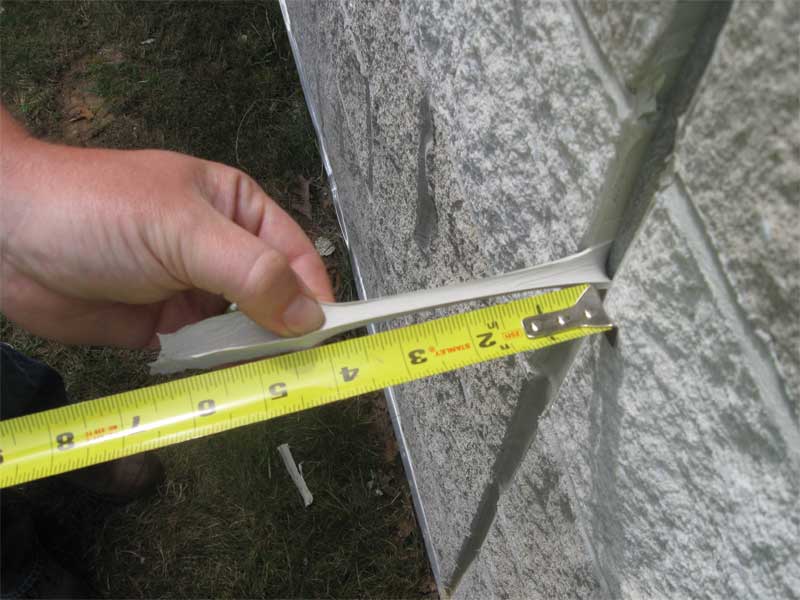 [8]
[8]A number of sealant types require surface primers prior to application, depending on the substrate. Primers can enhance adhesion, prevent the sealant from diffusing into the substrate, and emulsify dirt particles remaining on the surface. The advantage to using a sealant that does not require a primer is there is less room for error on the part of the installer, and skipping the priming step cuts down on application time and cost. However, some of the sealants requiring a primer perform better overall than their direct-application counterparts, so the additional time and oversight required for primer use may be worthwhile in the long run.
Weather conditions on the day of application can affect sealant performance. A significant percentage of sealant failures may be attributed to noncompliance with manufacturer instructions regarding installation. Ideally, sealant should be installed at the median of the design range, meaning the sealant has room to elongate or compress to accommodate fluctuations in temperature. If the sealant is installed in very cold weather, for instance, the substrate has shrunk and the joint is at its widest. As the weather warms and the substrate expands, compressive forces may exceed the sealant’s tolerance, leading to failure. The converse is also true; sealant installed in hot weather may stretch beyond capacity as the weather cools and the substrate contracts. Sealant installed at moderate temperatures retains the flexibility to accommodate the upper and lower ends of the design range.
Sealant viscosity also varies with temperature. If the temperature is very hot, sealant may sag; cold sealant, on the other hand, may be thick and difficult to tool. High humidity, frost, dew, or dampness can also lead to failure, as sealant will not adhere properly to a surface that is not dry.
Correct joint preparation and tooling are essential. Using a backer rod prevents three-sided adhesion for moving joints, and it helps to achieve correct sealant depth and profile. Without a bond-breaker at the back of the joint, sealant adheres to all three sides, leading to adhesive or cohesive failure—or both. To understand how this works, picture stretching a rubber band. This is how a sealant joint is meant to operate: one’s hands are the substrate, stretching and relaxing the rubber band, which represents the sealant. Now imagine grasping the rubber bands with the hands very close together, leaving only a tiny bit of the band to stretch and contract. Similarly, three-sided adhesion restricts elongation, as the bond area imposes additional stress on the sealant.
 [9]
[9]Sloppy tooling may result in voids, gaps, and irregular sealant thickness, causing stresses to act unevenly along the joint. Ideally, sealant should follow the curve of the cylindrical backer rod, with a concave tooled surface, such that it resembles an hourglass in a cross-section.
Reversion
Some organic sealants, especially polyurethanes, have the potential for reversion failure, in which they return to an uncured or gummy state in response to UV light exposure and moisture. Although manufacturers became aware of this problem more than a decade ago and have modified their products accordingly, owners and managers of buildings with older sealants should be on the lookout for signs of reversion. Keeping tabs on the consistency and performance of sealants should be part of a routine maintenance program.
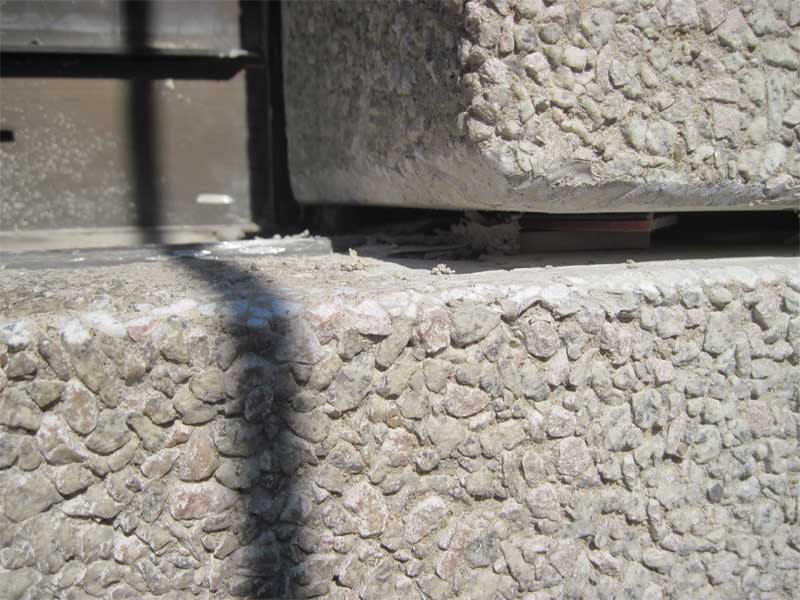 [10]
[10]Imprecise specification
Sometimes, incorrect sealant use is not entirely the installer’s fault. For instance, contradictions between drawings and specifications, or instructions going against relevant design standards or manufacturers’ guidelines, may cause unnecessary confusion. Careless material specification may stipulate particular sealant properties, while specifying sealant products without those properties. Drawings and documents may be unclear as to which sealant types are to be used in which locations. Any number of other errors and inconsistencies in the contract documents can leave the installation open to guesswork—with a high potential for failure.
Performance testing
Before embarking on a sealant replacement project, it is prudent to assess the suitability of the sealant product for the given application. A good place to start is manufacturer verification. Is the sealant compatible with the substrate? Will the product meet adhesion and elasticity requirements for the estimated joint movement? Is the sealant prone to discoloration or staining? Manufacturers can answer these and other general questions to verify the properties of a sealant under consideration. However, field conditions vary, and it is a good idea to test products onsite whenever feasible.
Peel tests for adhesion involve applying sealant to a test area, allowing it to cure, and evaluating the elongation prior to fracture or loss of adhesion. Especially for older buildings, it is important to assess multiple substrates and locations, as aging may cause different areas of the building to respond differently to the same sealant product. Multiple tests comparing different surface preparation methods can help determine the best balance between efficiency and good sealant-substrate bond.
Laboratory testing may provide more in-depth and detailed information than a field test. In the lab, it is possible to vary conditions for application and curing, so a sealant product may be tested in many possible scenarios. The downside is lab testing is not done under actual field conditions, which may vary from those simulated in a laboratory setting. Plus, many manufacturers require adhesion tests performed onsite, which means lab testing would need to be done in addition to, not in lieu of, field testing.
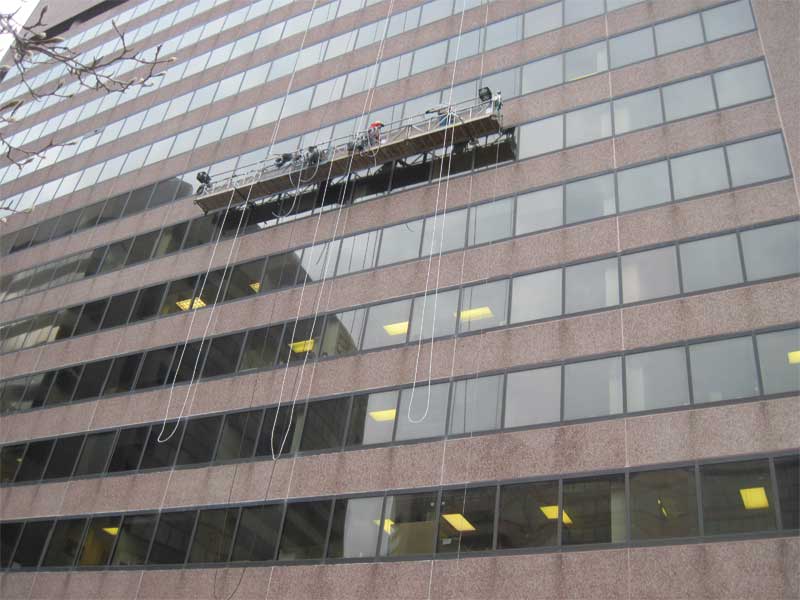 [11]
[11]Sealant joint rehabilitation
Where feasible, sealant replacement projects should begin by resolving original design flaws in joint dimensions and spacing. Joint preparation should involve removal of existing sealant, dirt, and debris through the use of grinding, compressed air, or wire brushing, as appropriate. Non-porous substrates may be cleaned with solvents, using the two-rag method: one rag for solvent application, followed immediately by a second clean, lint-free rag to dry the surface.
Next, appropriate primer may be applied according to the manufacturer’s recommendations. Surfaces should be primed before backer rods are inserted into the joint. The backer rod provides resistance to the pressure applied during tooling, helping to achieve the correct width-to-depth ratio and a smooth sealant surface. Typically composed of polyethylene or urethane foam, backer rods are categorized as open- or closed-cell. Open-cell backer rods allow air to circulate behind the sealant, permitting even curing; however, these are not appropriate for horizontal or submerged joints, where they can absorb and retain water.
Other pitfalls to avoid include:
- using sealant that has reached or exceeded its
shelf life; - storing sealant in a location subject to extreme temperatures;
- mixing multicomponent sealants incorrectly; and
- applying irregular pressure and flow with the sealant gun.
The number and variety of occasions for error in a sealant replacement project make it especially important to have a project team member tasked with onsite quality control, to see installation meets the manufacturer’s warranty requirements for testing and inspection. If problems are identified straightaway, they may be rectified before it is too late.
Sealant success
The limited lifespan of sealants means they inevitably need to be replaced. Achieving the full expected service life of a sealant typically requires a combination of correct joint design, appropriate sealant selection, product performance testing, appropriate surface preparation, and conformance to manufacturers’ guidelines and industry standards. A good reference is ASTM C1193, Standard Guide for Use of Joint Sealants, which provides in-depth information on joint design and sealant installation.
Sound sealant joints are necessary to a building’s ability to resist water infiltration and respond to movement. Although they may seem to require little more than a shot from a caulk gun, sealant joints demand care and attention if the building envelope is to perform as intended.
Arthur L. Sanders, AIA, CSI, CDT, is director (architecture) with Hoffmann Architects, an architecture and engineering firm specializing in the rehabilitation of building exteriors. President of the Connecticut Chapter of the American Institute of Architects (AIA), he is a longtime CSI member and a certified Construction Documents Technologist (CDT). He is also active in the Connecticut Building Congress, the Society for Protective Coatings (SSPC), and the National Trust for Historic Preservation. An alumnus of Yale University, he has extensive experience in architectural remediation, including the design, specification, and rehabilitation of sealant joints. Sanders may be reached at a.sanders@hoffarch.com[12].
Lawrence E. Keenan, AIA, PE, is director (engineering) with Hoffmann Architects and serves as manager of technical staff for the Connecticut office. With multiple patents for innovative joint design in precast concrete parking structures, he has presented papers at conferences of the Precast Concrete Institute (PCI), the Society of Structural Engineers, and the International Concrete Repair Institute (ICRI), where he is president of the Connecticut Chapter. A graduate of the University of Connecticut School of Engineering, he is both a professional engineer and a registered architect. He may be reached at l.keenan@hoffarch.com[13].
- [Image]: https://www.constructionspecifier.com/wp-content/uploads/2018/06/HoffArch11.jpg
- [Image]: https://www.constructionspecifier.com/wp-content/uploads/2018/06/HoffArch01.jpg
- [Image]: https://www.constructionspecifier.com/wp-content/uploads/2018/06/HoffArch02.jpg
- [Image]: https://www.constructionspecifier.com/wp-content/uploads/2018/06/HoffArch03.jpg
- [Image]: https://www.constructionspecifier.com/wp-content/uploads/2018/06/HoffArch06.jpg
- [Image]: https://www.constructionspecifier.com/wp-content/uploads/2018/06/HoffArch04.jpg
- [Image]: https://www.constructionspecifier.com/wp-content/uploads/2018/06/HoffArch05.jpg
- [Image]: https://www.constructionspecifier.com/wp-content/uploads/2018/06/HoffArch07.jpg
- [Image]: https://www.constructionspecifier.com/wp-content/uploads/2018/06/HoffArch08.jpg
- [Image]: https://www.constructionspecifier.com/wp-content/uploads/2018/06/HoffArch09.jpg
- [Image]: https://www.constructionspecifier.com/wp-content/uploads/2018/06/HoffArch10.jpg
- a.sanders@hoffarch.com: mailto:a.sanders@hoffarch.com
- l.keenan@hoffarch.com: mailto:l.keenan@hoffarch.com
Source URL: https://www.constructionspecifier.com/sealant-joint-solutions/